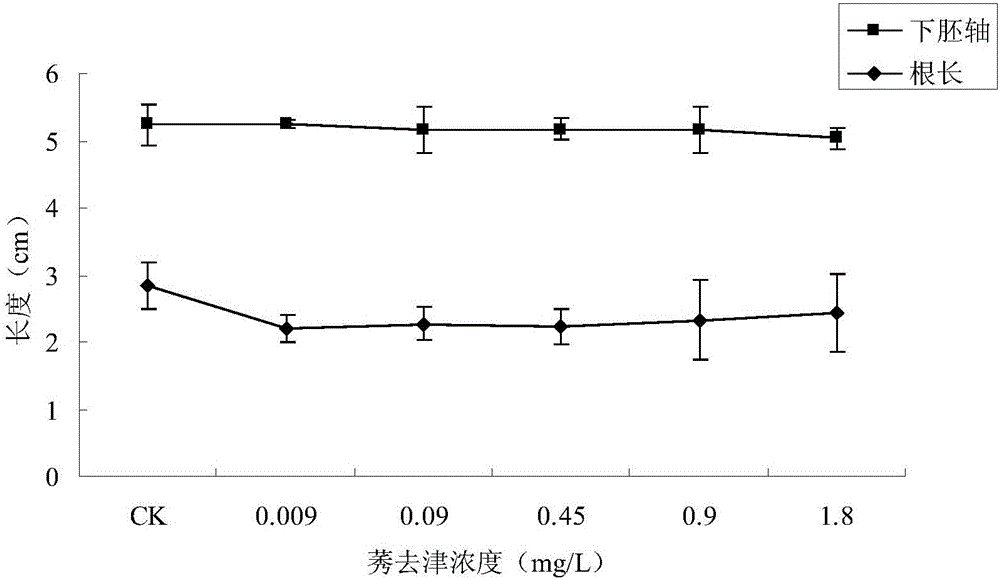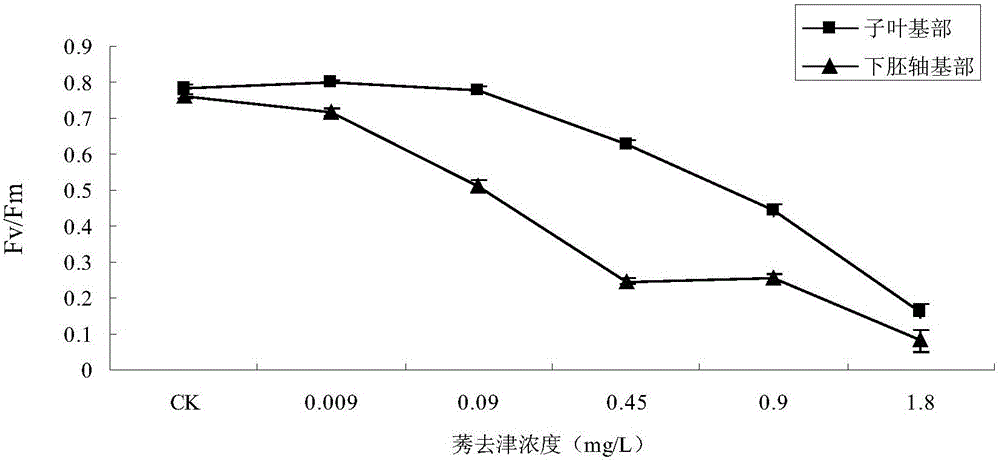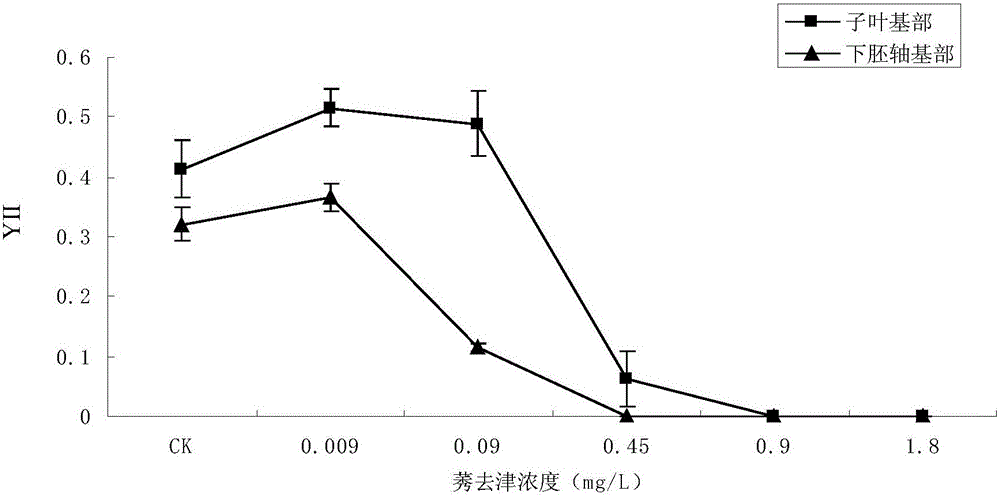Rapid identification method for atrazine residual phytotoxicity and application thereof
An identification method, the technology of atrazine, applied in the field of pesticide detection, can solve the problems of inhibited plant growth, decreased yield, difficult to accurately judge, etc., and achieve the effects of low identification limit, fast result and easy operation
- Summary
- Abstract
- Description
- Claims
- Application Information
AI Technical Summary
Problems solved by technology
Method used
Image
Examples
Embodiment 1
[0038] (1) Put the sterilized cucumber seeds without phytotoxicity into the seed germination box, place them in a biochemical incubator at 28-30° C. to accelerate germination, until the crops germinate and grow about 0.5-1 cm long, take them out for later use.
[0039] (2) Configuration of atrazine gradient concentration solution: use conventional complete nutrient solution to prepare atrazine solutions with different concentration gradients 0.009mga.i. / L, 0.09mga.i. / L, 0.45mga.i. / L, 0.9mga.i. / L, 1.8mga.i. / L.
[0040] (3) Take 100mL of atrazine solutions of different concentrations, add 5 germinated seeds, and put the blank culture solution as a control, culture in a light incubator, culture conditions: temperature: day / night: 28 / 25°C, light cycle For: 12h / 12h, the light intensity is 3500~4000lx.
[0041] (4) After 5 days of cultivation, the crop seedlings were taken out of the light incubator and adapted to the dark for 15-20 minutes, then put into the measurement box, and t...
Embodiment 2
[0043] (1) Put the sterilized cucumber seeds without phytotoxicity into the seed germination box, place them in a biochemical incubator at 28-30° C. to accelerate germination, until the crops germinate and grow about 0.5-1 cm long, take them out for later use.
[0044] (2) Configuration of atrazine gradient concentration solution: use complete nutrient solution to configure atrazine solutions with different concentration gradients 0.009mga.i. / L, 0.09mga.i. / L, 0.45mga.i. / L, 0.9 mga.i. / L, 1.8 mga.i. / L.
[0045] (3) Take 100mL solutions of different concentrations, add 5 germinated seeds, and place them in a light incubator for cultivation. Two groups of four replicates, one group for 5 days, and one group for 11 days. Night: 28 / 25°C, light cycle: 12h / 12h, light intensity 3500-4000lx.
[0046] (4) After cultivating for 5 days and 11 days respectively, take the crop seedlings out of the light incubator, measure the root length and hypocotyl length, and observe the growth status o...
Embodiment 3
[0051] (1) Put the sterilized non-toxic cowpea seeds into a seed germination box, place them in a biochemical incubator at 28-30° C. to accelerate germination, until the crops germinate and grow about 0.5-1 cm long, take them out for later use.
[0052] (2) Configuration of atrazine gradient concentration solution: use complete nutrient solution to configure atrazine solutions with different concentration gradients 0.009mga.i. / L, 0.09mga.i. / L, 0.45mga.i. / L, 0.9 mga.i. / L, 1.8 mga.i. / L.
[0053] (3) Take 100mL solutions of different concentrations, add 5 germinated seeds, and place them in a light incubator for cultivation. Two groups of four replicates, one group for 5 days, and one group for 11 days. Night: 28 / 25°C, light cycle: 12h / 12h, light intensity 3500-4000lx.
[0054] (4) After cultivating for 5 days and 11 days respectively, take the crop seedlings out of the light incubator, measure the root length and hypocotyl length, and observe the growth status of the plants, ad...
PUM
 Login to View More
Login to View More Abstract
Description
Claims
Application Information
 Login to View More
Login to View More - Generate Ideas
- Intellectual Property
- Life Sciences
- Materials
- Tech Scout
- Unparalleled Data Quality
- Higher Quality Content
- 60% Fewer Hallucinations
Browse by: Latest US Patents, China's latest patents, Technical Efficacy Thesaurus, Application Domain, Technology Topic, Popular Technical Reports.
© 2025 PatSnap. All rights reserved.Legal|Privacy policy|Modern Slavery Act Transparency Statement|Sitemap|About US| Contact US: help@patsnap.com



